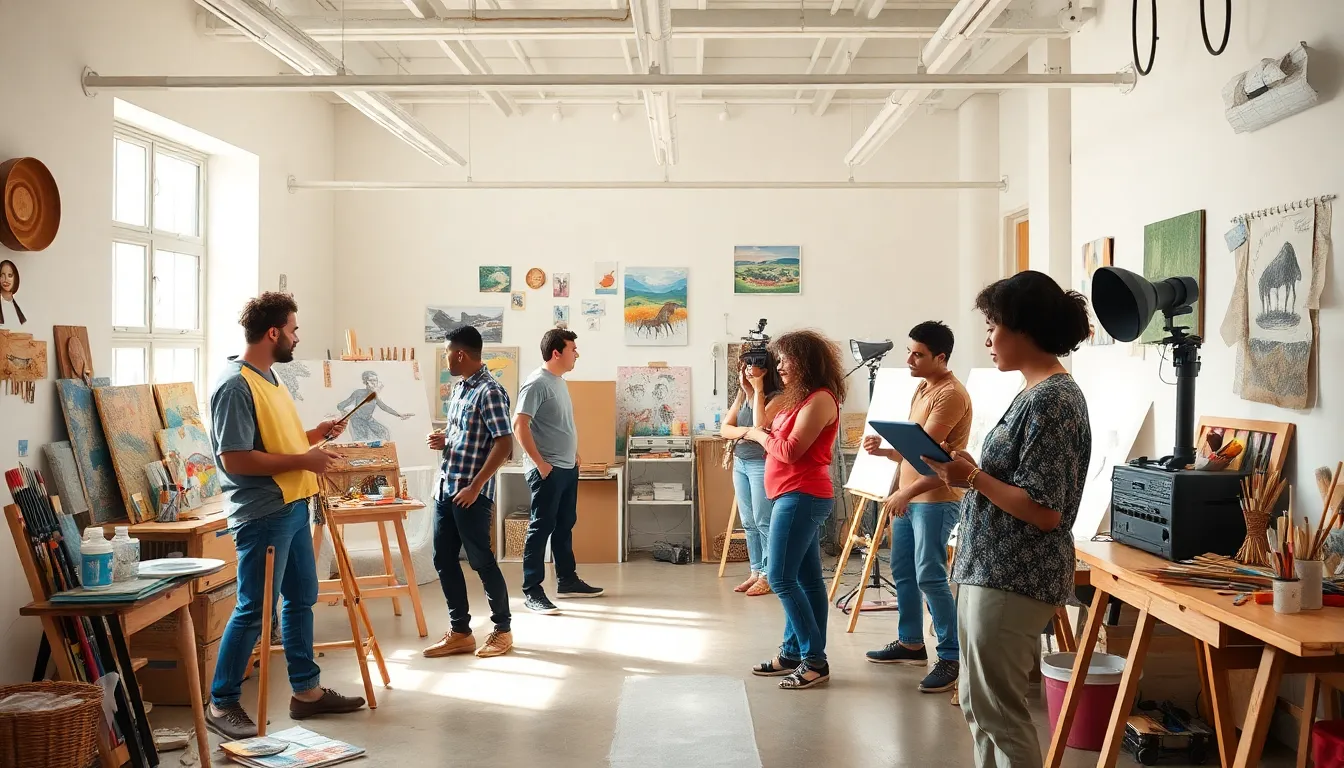In a world where scrolling through endless feeds has become the norm, media arts stands out as a vibrant blend of creativity and technology. It’s not just about pretty pictures or catchy tunes; it’s the magic that transforms ideas into engaging experiences. Think of it as the secret sauce that spices up everything from films and video games to graphic design and digital storytelling.
What Is Media Arts
Media arts represent a blend of creative expression and technological innovation. This dynamic field encompasses various forms of communication, connecting audiences through visual and auditory experiences.
Definition of Media Arts
Media arts encompass multiple disciplines, including film, animation, video production, and digital design. This term refers to any artistic expression that utilizes digital technology. It combines elements like sound, video, and graphics to create engaging narratives. This field encompasses both traditional and contemporary practices, reflecting society’s evolving relationship with technology. Media arts engage with audiences on personal and communal levels, emphasizing interactivity and engagement.
Historical Context
The evolution of media arts reflects significant cultural shifts throughout history. In the early 20th century, pioneers like Walt Disney and Sergei Eisenstein advanced storytelling through animation and film. The introduction of television in the 1950s revolutionized how narratives reached the masses. As technology progressed, the rise of personal computers in the 1980s expanded the medium to graphic design and digital music. Today, social media platforms further democratize creation and distribution, allowing artists to connect directly with their audience. As a result, media arts continue to shape and reflect contemporary culture.
Types of Media Arts

Media arts encompass various forms, each utilizing technology and creativity in distinct ways. These types include digital media, performance art, and visual arts, contributing to the rich landscape of artistic expression.
Digital Media
Digital media encompasses many formats, such as video, audio, and interactive applications. It utilizes electronic devices to create and distribute content, enhancing user engagement. Examples include podcasts, social media content, and online video platforms. This medium has transformed how artists reach audiences, enabling instant feedback and sharing capabilities. As a result, creators leverage digital tools for innovative storytelling experiences that transcend traditional boundaries.
Performance Art
Performance art merges visual elements with human expression to convey complex ideas. Artists may use their bodies as the primary medium, often incorporating audience interaction. Events range from theatrical performances to live installations, emphasizing spontaneity and presence. Artists challenge conventional norms, inviting viewers to experience art in real-time. Such performances can evoke strong emotional responses, forming a deeper connection between artist and audience.
Visual Arts
Visual arts encompass various techniques and mediums, including painting, sculpture, and photography. Artists utilize these forms to convey messages, emotions, and ideas. Techniques such as painting styles or digital manipulation offer diverse avenues for expression. Visual arts also include graphic design and illustrations, which communicate messages visually. By relying on aesthetics and composition, artists create meaningful visual experiences that enrich culture and provoke thought.
The Role of Media Arts in Society
Media arts significantly shape society, influencing both cultural identity and educational frameworks. They reflect contemporary issues while fostering creativity and critical thinking.
Influence on Culture
Media arts play a crucial role in defining and expressing cultural narratives. Films, music, and digital content contribute to social conversations, helping diverse voices reach wider audiences. Through storytelling, they challenge societal norms and provoke thought. Iconic filmmakers like Walt Disney and Sergei Eisenstein showcased how media arts can drive cultural movements. Current platforms further amplify this impact, democratizing content creation and allowing underrepresented communities to share their stories.
Educational Value
Media arts also hold substantial educational value, enhancing learning experiences across disciplines. They engage students through interactive projects, promoting teamwork and collaboration. Teachers utilize media arts to illustrate complex concepts, making lessons more relatable and impactful. Noteworthy is the integration of digital tools in classrooms, which fosters creativity and critical analysis. Various programs focus on skills such as video production and graphic design, preparing students for future careers in increasingly digital work environments.
Technological Advancements in Media Arts
Technological advancements play a crucial role in transforming media arts. They enhance creative expression, allowing artists to explore new mediums and reach broader audiences.
Impact of Digital Technology
Digital technology revolutionizes how artists create and share their work. High-definition cameras and user-friendly software streamline video production, making it accessible to aspiring creators. Social media platforms serve as tools for distribution, helping independent artists connect with global audiences. Audience engagement increases through interactive content such as virtual reality experiences and immersive environments. The rise of smartphones and tablets has facilitated on-the-go content creation and consumption. This technological ease empowers artists to experiment with innovative concepts and diverse formats.
Emerging Trends
Emerging trends in media arts reflect shifts towards inclusivity and sustainability. Virtual reality and augmented reality applications gain popularity, transforming storytelling into interactive experiences. Artificial intelligence assists in content creation, offering tools that enhance creativity. Meanwhile, environmentally conscious materials and practices shape production processes, promoting sustainability within the industry. The integration of blockchain technology in digital art offers new ways to authenticate and monetize creations. Collaborative projects across disciplines also thrive, fostering a creative community that cherishes diverse perspectives.
Conclusion
Media arts represent a vibrant intersection of creativity and technology that continually evolves. As a powerful medium for expression it shapes cultural narratives and fosters community engagement. The diverse forms of media arts not only enhance artistic exploration but also serve as vital tools for education and social commentary.
With advancements in technology artists can push boundaries and reach wider audiences than ever before. The future of media arts lies in its ability to adapt to new trends while remaining a crucial part of contemporary culture. As it continues to develop it will undoubtedly inspire future generations to innovate and connect through their creative endeavors.



